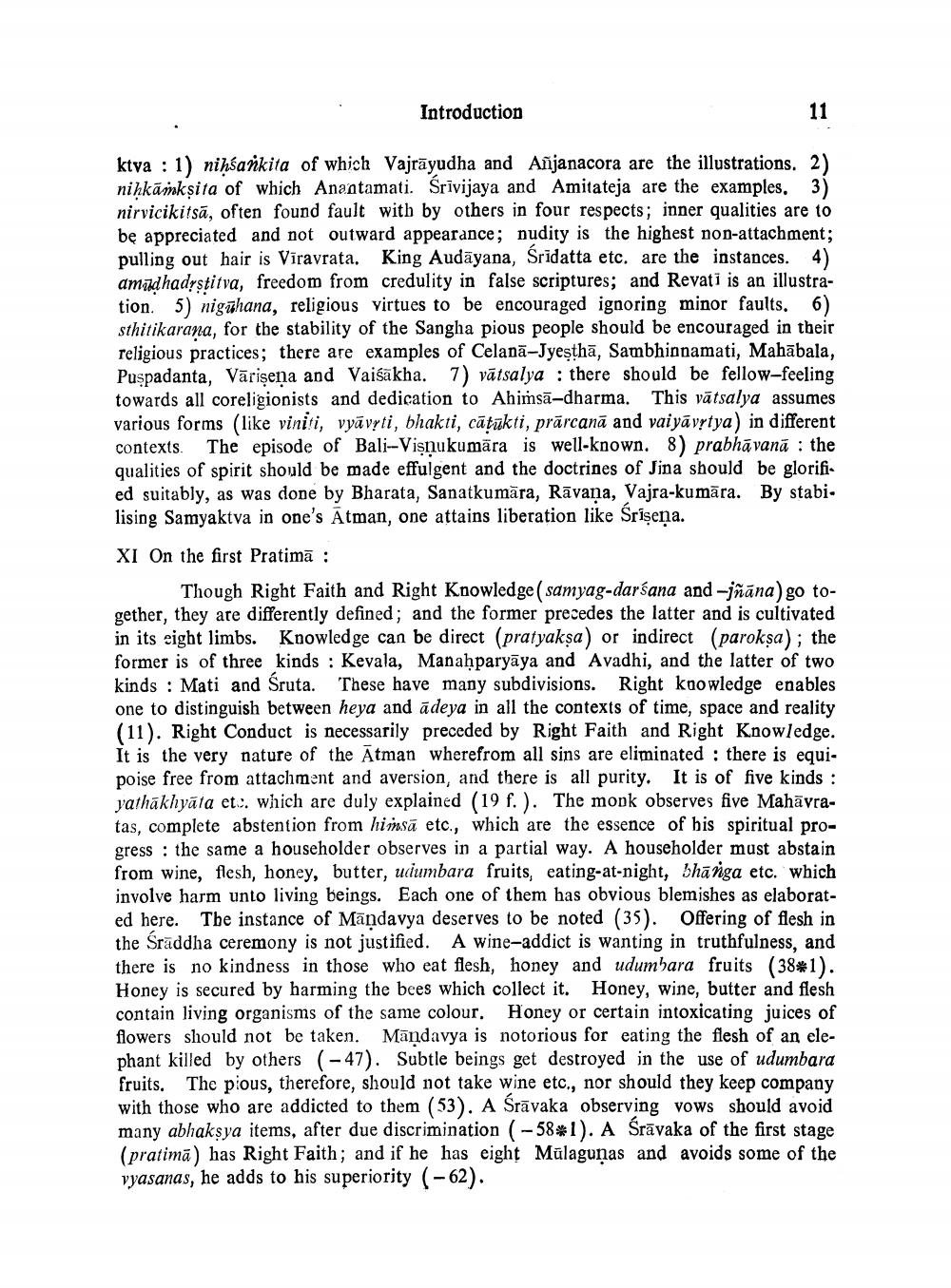________________
Introduction
11
ktva: 1) nihankita of which Vajrayudha and Anjanacora are the illustrations. 2) nikkamkṣita of which Anaatamati. Srivijaya and Amitateja are the examples, 3) nirvicikitsa, often found fault with by others in four respects; inner qualities are to be appreciated and not outward appearance; nudity is the highest non-attachment; pulling out hair is Viravrata. King Audayana, Śridatta etc. are the instances. 4) amadhadrstitva, freedom from credulity in false scriptures; and Revati is an illustration. 5) nigahana, religious virtues to be encouraged ignoring minor faults. 6) sthitikarana, for the stability of the Sangha pious people should be encouraged in their religious practices; there are examples of Celana-Jyesthä, Sambhinnamati, Mahabala, Puspadanta, Värişeṇa and Vaisakha. 7) vätsalya: there should be fellow-feeling towards all coreligionists and dedication to Ahimsa-dharma. This vatsalya assumes various forms (like viniti, vyavrti, bhakti, caṭakti, prärcana and vaiyavṛtya) in different The episode of Bali-Visnukumara is well-known. 8) prabhavana: the qualities of spirit should be made effulgent and the doctrines of Jina should be glorified suitably, as was done by Bharata, Sanatkumara, Rāvana, Vajra-kumara. By stabilising Samyaktva in one's Atman, one attains liberation like Śrisena.
XI On the first Pratima :
Though Right Faith and Right Knowledge (samyag-darśana and -jñāna) go together, they are differently defined; and the former precedes the latter and is cultivated in its eight limbs. Knowledge can be direct (pratyaksa) or indirect (paroksa); the former is of three kinds: Kevala, Manaḥparyaya and Avadhi, and the latter of two kinds Mati and Śruta. These have many subdivisions. Right knowledge enables one to distinguish between heya and adeya in all the contexts of time, space and reality (11). Right Conduct is necessarily preceded by Right Faith and Right Knowledge. It is the very nature of the Atman wherefrom all sins are eliminated: there is equipoise free from attachment and aversion, and there is all purity. It is of five kinds : yathakhyāta et. which are duly explained (19 f.). The monk observes five Mahavratas, complete abstention from himsa etc., which are the essence of his spiritual progress the same a householder observes in a partial way. A householder must abstain from wine, flesh, honey, butter, udumbara fruits, eating-at-night, bhanga etc. which involve harm unto living beings. Each one of them has obvious blemishes as elaborated here. The instance of Mandavya deserves to be noted (35). Offering of flesh in the Śraddha ceremony is not justified. A wine-addict is wanting in truthfulness, and there is no kindness in those who eat flesh, honey and udumbara fruits (381). Honey is secured by harming the bees which collect it. Honey, wine, butter and flesh contain living organisms of the same colour. Honey or certain intoxicating juices of flowers should not be taken. Mandavya is notorious for eating the flesh of an elephant killed by others (-47). Subtle beings get destroyed in the use of udumbara fruits. The pious, therefore, should not take wine etc., nor should they keep company with those who are addicted to them (53). A Śravaka observing vows should avoid many ablakṣya items, after due discrimination (-581). A Sravaka of the first stage (pratima) has Right Faith; and if he has eight Malagunas and avoids some of the vyasanas, he adds to his superiority (-62).




